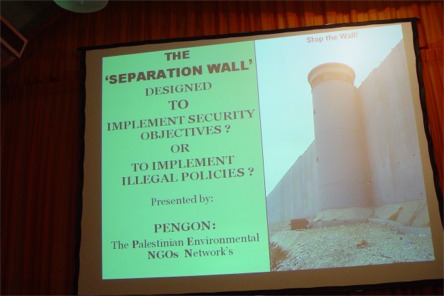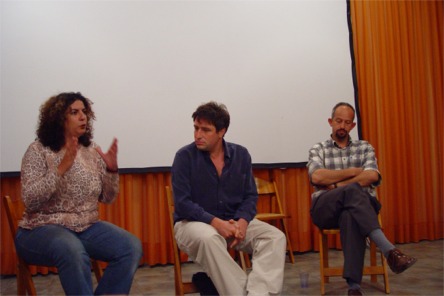Home > Oasis of Peace > Projects & Outreach > Doumia-Sakinah: The Pluralistic Spiritual Centre > Behind the Fence
Behind the Fence
Film, presentation and discussion evening
Monday 6 October 2003

Tuesday, September 30: The Pluralistic Spiritual Centre, in cooperation with the School for Peace, convened a meeting based on a film screening and a presentation on the subject of Israel’s security fence.
The issue of Israel’s security fence is certainly the hottest issue currently affecting the relations between Israelis and Palestinians. The majority of the former claim that the wall is a necessity due to the worsening security situation, while the latter see the wall’s construction as a further nail in the coffin of the Oslo peace process. It seems, on the basis of tonight’s film and lecture that few people on either side, or in the world as a whole, have grasped the full destructive extent of the project. The purpose of the evening was not to explore the justification, or lack of justification for building the fence, but to look at its influence upon the lives of the Palestinians who are principally affected by it.
The evening opened with the screening of the BBC commissioned documentary BEHIND THE FENCE, in the presence of the producer, Osnat Trabelsi and the director, Inigo Gilmore. Filmed in 2002-2003 over 10 months, the film shows how the fence changes the lives of Palestinians and Israelis by focussing on three personal stories.
After the film, Mr. Jamal Jumaa from the Palestinian Environmental NGO’s Network (PENGON) gave an in-depth presentation on the subject of the security fence (see below). This was followed by a discussion, with questions directed to Trabelsi, Gilmore and Jumaa.

Jamal Jumaa’s presentation
It was not obvious till June 2002 that the wall would be built, and nothing about it was published. It was hard to know what was going on. We produced the first maps by following confiscation orders given to farmers. Later in Spring 2003, while the world was occupied with the events in Iraq, it became more obvious.
The first plans were published by the Yesha (West Bank settlers) council. Since then there has been lots of bargaining between the government and the settlers, etc. Final maps of the wall were produced only in May 2003. The first section to be built was around Kalkilia.
The barrier (with its patrol roads, trenches, etc.) is based sometimes on a concrete wall and sometimes on a fence. Around Kalkilia, where it is a concrete wall, you feel as if you are in a prison. Kalkilia is one of the most critical cases: Just to go there requires special permission. Kalkilia was a city that served the entire region. Some 85,000 people would come there each day to shop. Now, no one gets in or out. This has forced 600 shops to close. Due to economic hardship 4,000 people have had to leave the city, and a quarter of the population is expected to leave. The city dwellers are depending on humanitarian assistance. Now it has been decided to cut further into Kalkilia in order to build a buffer wall, 150 meters inside the existing wall. They felt they needed to build another trench, in order to protect the wall.
More than 13,000 people have been made homeless so far by the wall. Some 145 kilometers of concrete wall have already been constructed. The wall’s ’footprint’ is up to 50 - 60 meters in width. For it, some 14,680 dunams (146.8 hectares) have been confiscated . More than 16,000 people have been isolated by the wall: these people can move neither into the West Bank nor into Israel.
Many villagers are divided from their land and their wells. There are gates, but most of these are for settlers and the army. To pass through and reach their fields, Palestinians are often given only two daily periods of 15 minutes: one in the morning and one in the evening – and these are usually at inconvenient times. Today there were clashes since it was decided that men under the age of 38 year were prohibited to pass. This is a serious problem since this is the period of the olive harvest, when whole families traditionally work together. However many of the olive trees - some 102,320 of them - have already been uprooted for the wall. Some of these trees were over 2,000 years old and had served the villagers for generations. Usually they are stolen by the contractors for replanting. Some farmers try to protect their land. Sixteen, from the village of Jayous, were beaten by soldiers in the last month. In the same area, 32 families decided to move onto their land to protect it, living like refugees.
Not all of the wall cuts through agricultural land. Already, 200 buildings have been demolished, and there are more everyday. Some towns have lost their markets. Nazlet Issa was one. Its market, including 200 shops, was demolished. As a consequence, 700 families lost their livelihood.
Where Palestinians are divided from their land, annexation of land and settlements may follow. Over 2% of the west bank has already been marooned west of the wall: some 121,000 acres. We know that the settlers already have expansion plans to use this land.
We think the fence is meant to be a (permanent) border. It is to be built in four phases, whose eventual route renders the 42% of the west bank of which Sharon talked of returning to the Palestinians. When completed, the Palestinians will be living in a number of isolated enclaves. The three main urban areas will resemble refugee camps. The parts of the West Bank left for Palestinians will be mainly the mountainous regions. They will be isolated from the main agricultural and water resources. We think that this reflects a deliberate policy of destroying the entire Palestinian infrastructure. What is certain is that the wall will further devastate the lives of Palestinians. Their struggle in the future will be mainly for food (rather than for independence).
The Israelis have said that they won’t let the Palestinians die. But what will happen is that they will become entirely dependent upon the industrial areas planned under Oslo. the original plan for four of these has expanded to 12 areas, which will be in settlement zones. The Palestinians will be able to travel to them through gates and then return to their homes.
Further information on the Security Fence can be found at the website www.stopthewall.org
A petition can be found here



